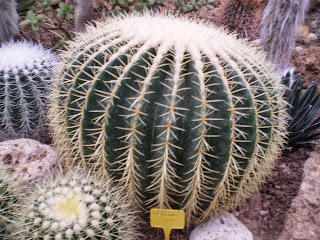The title of this blog is 'Salvia Garden', but although there are several Salvias growing in this garden, it has much more to offer.
Mr. and Mrs. Patry, started 15 years ago with the aim of creating a garden with minimal water requirements. On the lower terraces of their 4000m2 plot, they planted olive trees. Initially they bought a lot of plants from Pepiniere Filippi in Meze, at that time, one of the few garden centres that specialised in plants that could stand the summer drought.
Their son, Guillaume, led us round the garden. He was very knowledgeable and pleasant, never tiring of all the questions members asked him.
He mentioned that they plant in the middle of September. As the weather is still nice, the soil is warm, new roots sprout easily. After planting he waters the plants once a week, till their roots have settled and grown. By summer the plants are well established and do not need watering. To prevent water loss, he uses wood chips as a mulch. As he has his own garden maintenance company and is a tree surgeon, he has a ready supply of wood chips.
Some of the Salvias growing in this garden are tender. I've given the lowest temperatures they can take as a guideline, taken from Christine Yeo's books on Salvias. Christine Yeo is a National Collection Holder of Salvias (NCCPG) in the U.K. In this particular garden they seem to cope with much lower temperatures. Often the tender Salvias die down during the winter to come up again in spring.
Salvia apiana - whole plant covered with white hairs, with pale lilac flowers, up to -3C.
Salvia azurea - up to -3C.
Salvia 'Blue Spires', sometimes called 'Mystic Blue Spires', dies down in winter, comes up in spring:
Salvia canariensis - growing near the house, up to -5/-6C:
Salvia darcyi, magnificent large red flowers -8C:
Salvia chamaedryoides (blue), up to -6C, together with Salvia greggi, up to -6C, many different varieties, discussed in last month blog on Salvias:
Blue flowering Salvia chamaedryoides with red, pink and salmon flowering Salvia greggii next to it
Salvia leucantha - flowers in autumn, up to -4C:
Salvia microphylla - many different varieties, various colours, discussed in last month's blog on Salvias, up to -10C.
Salvia microphylla var. neurepia has very large leaves with large red flowers:
Salvia pomifera - not in flower, very nice grey crinkly leaves, up to -10C:
Salvia uliginosa - requires regular watering - light blue flowers, dies down in winter, up to -10C:
In addition to Salvias there are many shrubs and trees, some of the lesser known ones:
Acacia karoo (long thorns)
Acca sellowiana (Feijoa)
Arbutus andrachne
Arbutus unedo - strawberry tree, native to the region, the fruits resemble strawberries, hence the name:
Buddleja alternifolia.
Ceratonia siliqua - Carob tree - the seedpod can be crushed and used as a chocolate substitute.
Pistachio vera - a male and female tree are required for it to set fruit.
Zanthoxylum simulans - Szechuan pepper tree, I tried them, spicy and acidic at the same time.
The owners introduced plants that grow naturally in the Mediterranean basin, to mention a few:
Euphorbia dendroides:
Euphorbia resinifera:
Euphorbia myrsinitis.
Euphorbia rigida - like myrsinitis but more upright:
Globularia alypum:
Grevillea:
Ptilostemon gnaphaloides, with thistle like lilac flowers:
Santolinas, with one in particular that stood out, Santolina 'Small Ness' :
Trachelium caeruleum :
I noticed several members asking Guillaume for the name of the plant below, Beschorneria yuccoides. This is what it looks like in flower:
The hills surrounding Les Arcs are made of a special type of limestone called 'Tufa'. Tufa is soft and very porous, water drains easily. Because of this 'Tufa', Mr. & Mrs. Patry were able to introduce exotic plants that you normally only find at the coast. In winter they protect the plants against the frost:
Agave attenuata
Agave parrya
Agave parviflora
Agave victoriae-reginae:
and Cacti. They even created a special sanctuary, a covered area built into the rocks to house the Cacti. As there is no natural rain water coming into this area, they are watered once a week:
Cephalocactus senilis, the grey hairy cactus, behind the Echinocactus:
Ferocactus stainesii, the 3 cacti close together, outlined in red:
Echinocactus grusonii:
At the end of our visit we were treated to a table full of Acca fruit. Quite delicious, an unusual flavour.
A big thank you to all our photographers, without them the blog would not be the same.
Clarisse sent an email mentioning a pepiniere, Le Sceau Vert, 800 m outside Salernes on the Route d'Entrecasteaux, on the right. They have a large selection of Salvias and very reasonably prized. Tel: 0621098825.
Photos: Elisabeth Boutevin, Hazel Francis, Gerda Nagtegaal and Isabel Pardoe.











































